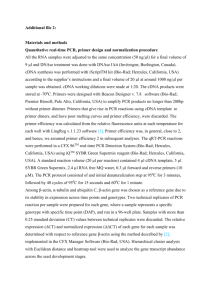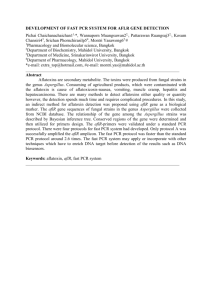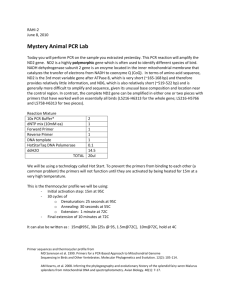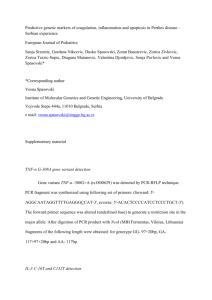Supporting Information: Appendix S1 Mechanism of the
advertisement
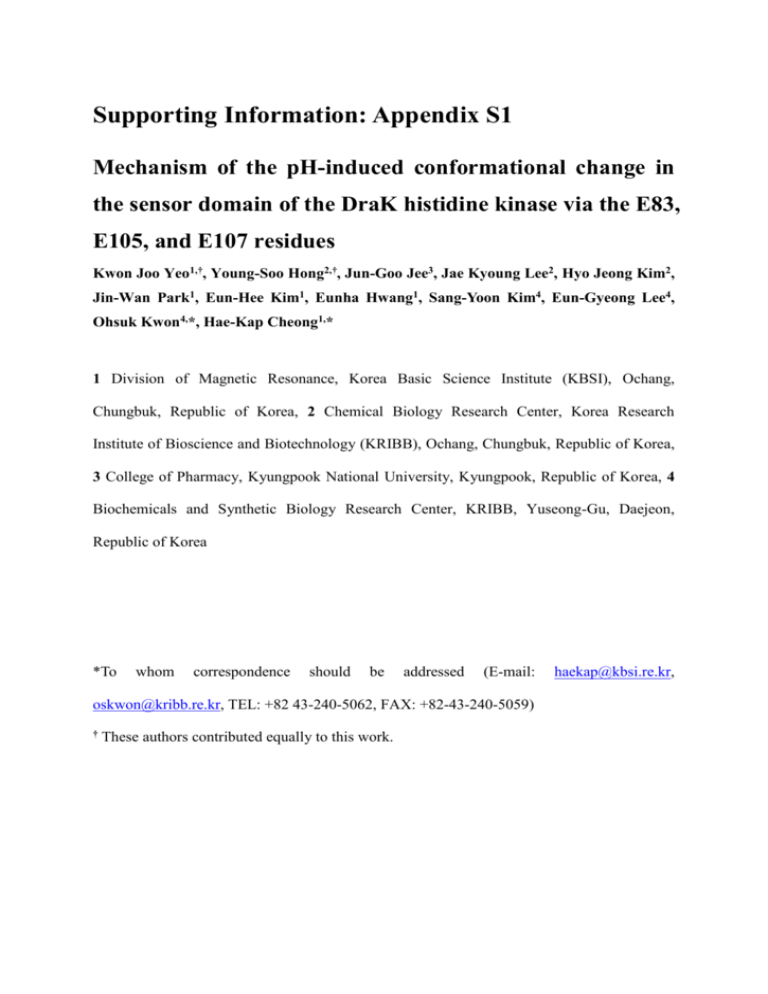
Supporting Information: Appendix S1 Mechanism of the pH-induced conformational change in the sensor domain of the DraK histidine kinase via the E83, E105, and E107 residues Kwon Joo Yeo1,†, Young-Soo Hong2,†, Jun-Goo Jee3, Jae Kyoung Lee2, Hyo Jeong Kim2, Jin-Wan Park1, Eun-Hee Kim1, Eunha Hwang1, Sang-Yoon Kim4, Eun-Gyeong Lee4, Ohsuk Kwon4,*, Hae-Kap Cheong1,* 1 Division of Magnetic Resonance, Korea Basic Science Institute (KBSI), Ochang, Chungbuk, Republic of Korea, 2 Chemical Biology Research Center, Korea Research Institute of Bioscience and Biotechnology (KRIBB), Ochang, Chungbuk, Republic of Korea, 3 College of Pharmacy, Kyungpook National University, Kyungpook, Republic of Korea, 4 Biochemicals and Synthetic Biology Research Center, KRIBB, Yuseong-Gu, Daejeon, Republic of Korea *To whom correspondence should be addressed (E-mail: oskwon@kribb.re.kr, TEL: +82 43-240-5062, FAX: +82-43-240-5059) † These authors contributed equally to this work. haekap@kbsi.re.kr, Construction of draR and draK gene deletion mutants in S. coelicolor. For draR (SCO3063) disruption, approximately 1.36 kb of the 5’ region of the draR gene was amplified from the genomic DNA of S. coelicolor by PCR using a forward primer with an EcoRI site added and a reverse primer with a PstI site added (Table S1). The PCR product was cloned into the pCR-TOPO2.1 vector to produce pTA-314. Approximately 1.2 kb of the 3’ region of the draR gene was also amplified by PCR using a primer set adding KpnI and HindIII sites to its 5’ and 3’ ends, respectively. The PCR product was cloned into the pCRTOPO2.1 vector to produce pTA-324. The pTA-314 plasmid was digested with EcoRI and PstI, and the pTA-324 plasmid was digested with KpnI and HindIII to isolate DNA fragments corresponding to the 5’- and 3’- flanking regions of draR, respectively. The 1.1 kb aphII gene (kanamycin resistance gene; KanR) was obtained from a PstI, KpnI-digested pFD-neoS plasmid [1]. All three fragments were ligated together into an EcoRI-HindIII digested pKC1139 vector to produce pKC-3063A [2]. The construct was inserted into S. coelicolor by conjugation with E. coli ET12567(pUZ8002). For draK (SCO3062) disruption, approximately 1.37 kb of the 5’ region of draK gene was amplified from the genomic DNA of S. coelicolor by PCR using a forward primer with an added EcoRI site and a reverse primer with an added PstI site (Table S1). The PCR product was cloned into the pCRTOPO2.1 vector to produce pTA-214. Approximately 1.58 kb of the 3’ region of draK was also amplified by PCR using a primer set adding KpnI and HindIII sites to its 5’ and 3’ ends, respectively. The PCR product obtained was cloned into the pCR-TOPO2.1 vector to produce pTA-224. The pTA-214 plasmid was digested with EcoRI and PstI, and the pTA-224 plasmid was digested with KpnI and HindIII to isolate DNA fragments corresponding to the 5’- and 3’- flanking regions of draK, respectively. The 1.1 kb aphII gene was obtained from a PstI, KpnI digested pFD-neoS plasmid [1]. All three fragments were ligated together into an EcoRI-HindIII digested pKC1139 vector to create pKC-3062B. The construct was inserted into S. coelicolor by conjugation with E. coli ET12567 (pUZ8002) [2]. Intergeneric conjugation between E. coli and Streptomyces was performed as previously described [2] with minor modifications. Transformants resistant to apramycin and kanamycin were selected and grown in fresh R2YE/kanamycin liquid medium at 37℃ for 4 days to force the integration of disruption cassette DNA from gene disruption vectors into chromosomal DNA. The resulting gene disruption mutants (draK and draR) were selected on R2YE/kanamycin medium and confirmed by PCR with the relevant primer sets (Table S1) using total genomic DNA from each mutant as template. PCR primers were designed around draR (SCO3063) and draK (SCO3062) with primers binding 5’ of the draR (SCO3063) and draK (SCO3062) gene regions for sense primers, and a sense primer region downstream was used for antisense (Table S1). As a result, 1.2 kb of the PCR product was detected for wild type and draR, and a 2.3 kb PCR product was shown for draK. This result demonstrated insertion of the aphII gene (1 kb) in the middle of the draK gene. A 1.4 kb PCR product was detected for the wild type and draK genes, and a 2.5 kb PCR product was observed for draR. This result demonstrated insertion of the aphII gene (1 kb) in the middle of the draR gene. In addition, PCR products with the C63-F and Neo-R primer set were detected for draK (2.4 kb) and draR (1.5 kb), and a PCR product was not observed for the wild type. This result demonstrated the insertion of the aphII gene (1 kb) in the draK and draR genes (Figure S2). Table S1. Primers used in this study. Target draR (SCO3063) draK (SCO3062) Name Sequences (5’-3’) Restriction Enzyme site 63-1E GAATTCTCGCCGATGGTGCCGATGGTCAGCGG EcoRI 63-2P CTGCAGCTCGGCGAGGCGGAAGGGCTTGGTG PstI 63-3K GGTACCGGGCCTGGATGGGAGAGGAGGAGCTC KpnI 63-4H AAGCTTGCCGGAGCTGACGATGGCCCGCCCC HindIII 62-1E GAATTCCCCCAGGATGGCACCCCACAGCCGCA EcoRI 62-2P CTGCAGCTCGGGGACGCCGTACCGCTTGTGCC PstI 62-3K GGTACCGGGTCGCGGACGTGCTGGACTCCTCC KpnI 62-4H GAAGCTTGAACCTGATGCCGAGCGGAAGCTT HindIII C63-F Mutant confirmation Neo-R GCTGCCGATCAGGAACTGGAGGACG CGCATCGCCTTCTATCGCCTT CTTG Figure S1. Inactivation of the draR (A) and draK (B) genes in S. coelicolor. KanR, kanamycin resistance gene; aprR, apramycin resistance gene. A) B) Figure S2. Confirmation of insertional gene inactivation by PCR using the total genomic DNA of each mutant as template (A). M, 1 kb ladder. The relevant primers used to amplify the desired DNA fragments are indicated (B). A) B) Figure S3. 1H-15N HQSC spectrum and backbone assignment for the ESD (E83Q) mutant at pH 4.5 (A). 1H-15N HQSC spectra for the wild type (red) and the E83Q mutant (blue) (B). A) B) Table S2. NMR restraints and statistics for the ensemble of the 20 lowest energy structures calculated for the DraK ESD. Average AMBER energies (kcal/mol) AMBER Constraint Completeness of resonance assignments (%) Conformation restricting restraints Distance restraints Intra (|i-j|=0) Sequential (|i-j|=1) Medium range (1<|i-j|<5) Long range (|i-j|>4) No. of restraints per residue No. of long-range restraints per residue Residual restraints violations Average no. of distance violation (> 0.5 Å) Average no. of angle violation (> 5.0°) Residual dipolar coupling restraints No. of restraints Average deviation (Hz) Average R-factor/Q-factor Model quality Rmsd backbone atoms (Å) (11-88 residues) Rmsd heavy atoms (Å) (11-88 residues) Rmsd bond lengths (Å) Rmsd bond angles (°) MolProbity Ramachandran statistics Most favored regions (%) Allowed regions (%) Disallowed regions (%) Global quality scores Verify3D ProsaII (Z-score) MolProbity clash score Model contents Ordered residue ranges Total no. of residues PDB ID code -4,212 10 99.8 1,750 398 488 390 474 19.4 5.3 0.0 (0.31 Å max) 0.0 (1.40 ° max) 82 0.81 0.993/0.073 0.29 0.78 0.011 2.1 88.1 11.9 0.0 0.28 -5.5 0.69 11–88 90 2MJ6 Figure S4. The change in the CD signal intensity of the E83D mutant at 218 nm over a pH range of 4.2-7.4. The midpoint of the transition occurs at approximately pH 5.7. Figure S5. 1H-15N HQSC spectrum for the ESD (E83L/E105L/E107A) mutant at pH 4.5 (A) and 7.5 (B) Figure S6. CD spectra for the ESD (E83L/E105L/E107A) mutant at pHs 4.5, 7.5 and 10.0 References 1. Denis F, Brzezinski R (1991) An improved aminoglycoside resistance gene cassette for use in gram-negative bacteria and Streptomyces. FEMS Microbiol Lett 65: 261-264. 2. Bierman M, Logan R, O'Brien K, Seno ET, Rao RN, et al. (1992) Plasmid cloning vectors for the conjugal transfer of DNA from Escherichia coli to Streptomyces spp. Gene 116: 43-49.

